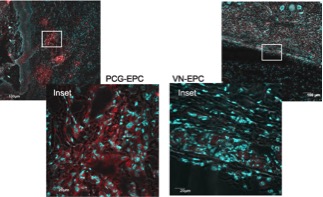Wound healing in diabetic conditions is severely impaired and is a major cause of extremity amputation. A cellular, tissue engineered, wound-healing product comprising of a novel matrix of electro-spun Polycaprolactone-Gelatin nano-fiber scaffold (PCG) with embedded Bone Marrow or Peripheral Blood-derived endothelial progenitor cells (BMPC) system has been developed by scientists at NCCS, for accelerated and fibrosis-free wound healing in diabetic conditions.

Figure 1: PCG-EPCs (Left) show efficient incorporation into wounds as compared to Vehicle Control VN-EPCs (Right)
This system promotes selective growth of BMPCs in the wounded area and works as a combined growth and delivery system for direct application onto wounds. This system can be developed into bandage style scaffolds for a ready-to-use cell therapy product. It has several advantages including:
- Treatment of non-healing ulcers in diabetic or burns patients,
- Fibrosis-free healing,
- Direct application onto skin repair sites including diabetic wounds,
- Bio-compatible,
- Easy handling in clinical settings,
- Cryopreserved for long shelf life; and
- Autologous cells can be used in the scaffold to reduce risk of rejection.
Technology Readiness: TRL B2 (In-vitro + In-vivo efficacy/ results demonstrated)
Technology Status: Patent Filed in India.
Technology Availability: Know-how available for transfer/ co-development with partners.
References:
- Enhanced Growth of Endothelial Precursor Cells on PCG- Matrix Facilitates Accelerated, Fibrosis-Free, Wound Healing: A Diabetic Mouse Model, PLOS One July 2013, Vol 8, Issue 7 (Article).
